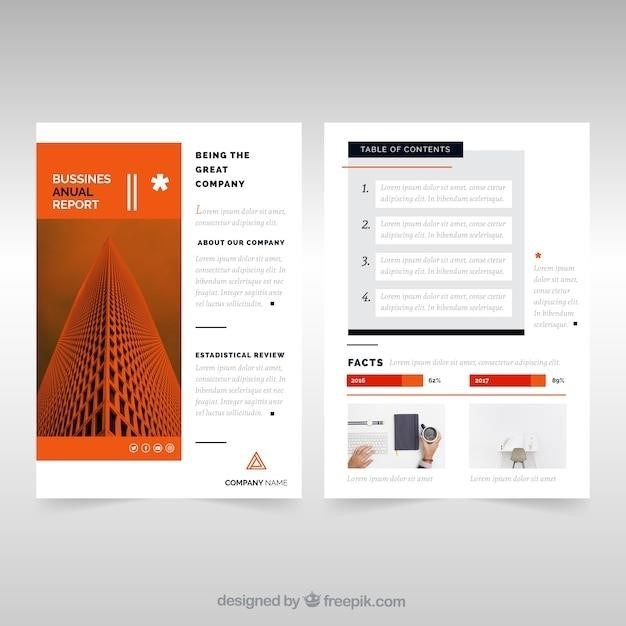
Manual Steel Construction PDF⁚ A Comprehensive Guide
The AISC Steel Construction Manual is an essential resource for engineers and designers involved in structural steel construction. This comprehensive guide provides a wealth of information on steel design, fabrication, and construction, covering a wide range of topics from basic principles to advanced concepts. The manual is widely used in the industry and is considered a definitive reference for steel construction practices.
Introduction
The AISC Steel Construction Manual is a cornerstone resource for professionals in the field of structural steel design and construction. This comprehensive guide, meticulously crafted by the American Institute of Steel Construction (AISC), offers a vast repository of knowledge, specifications, and design aids for engineers, architects, and contractors. Originally published in 1927, the manual has undergone numerous revisions and updates, ensuring its continued relevance and alignment with the latest advancements in steel construction practices. The AISC Steel Construction Manual stands as a testament to the AISC’s commitment to advancing steel construction techniques, promoting safety, and fostering innovation within the industry. This manual serves as a vital tool for professionals seeking to design, fabricate, and construct safe, efficient, and durable steel structures.
What is the AISC Steel Construction Manual?
The AISC Steel Construction Manual is a comprehensive reference guide published by the American Institute of Steel Construction (AISC). It serves as a definitive resource for engineers, architects, and other professionals involved in the design, fabrication, and construction of structural steel buildings and bridges. The manual encompasses a wide range of topics, including design specifications, load tables, connection details, and construction practices. It is a valuable tool for ensuring that steel structures are designed, fabricated, and erected in accordance with the latest industry standards and best practices. The manual is widely recognized and accepted as the authoritative source for steel construction information in the United States and beyond.
History and Editions
The AISC Steel Construction Manual has a long and distinguished history, dating back to its first publication in 1927. Over the years, the manual has undergone numerous revisions and updates to reflect advancements in steel technology, design methods, and construction practices. The manual is typically updated and reissued every five to six years to incorporate the latest codes, standards, and research findings. Each edition represents a significant milestone in the evolution of steel construction practices. The most recent edition is the 16th, published in 2023. The 15th edition was published in 2017. The manual’s continuous evolution ensures that it remains a valuable resource for professionals in the field, providing them with the most up-to-date information and guidance on steel construction.
Key Features and Content
The AISC Steel Construction Manual is a comprehensive resource that covers a wide range of topics related to structural steel design and construction. The manual is divided into several sections, each focusing on a specific aspect of steel construction. It provides detailed information on various topics, including the properties of steel, design methods for beams, girders, and columns, connection design, and relevant specifications and codes. The manual is also known for its clear and concise writing style, making it easy for users to find the information they need. The manual includes numerous tables, charts, and illustrations to aid in understanding complex concepts and providing practical design guidance.

Dimensions and Properties
The AISC Steel Construction Manual provides extensive information on the dimensions and properties of various steel shapes commonly used in structural construction. This section includes detailed tables and charts outlining the physical properties of steel shapes, such as their cross-sectional areas, moments of inertia, and radii of gyration. These properties are essential for engineers to accurately calculate the strength and stability of steel members in structural designs. The manual also provides information on the material properties of steel, including its yield strength, tensile strength, and modulus of elasticity, which are crucial for determining the load-carrying capacity of steel structures.
Beam and Girder Design
The AISC Steel Construction Manual provides detailed guidance on the design of steel beams and girders, essential components of structural steel frameworks. The manual outlines various design methods, including the Allowable Strength Design (ASD) and Load and Resistance Factor Design (LRFD) methods, which are used to determine the capacity of beams and girders to resist bending, shear, and torsion. The manual also includes tables and formulas for calculating the bending moment, shear force, and deflection of beams under various loading conditions. Furthermore, the manual provides recommendations on the selection of appropriate beam sections and connections, considering factors such as span length, loading patterns, and fabrication constraints.
Column Design
The AISC Steel Construction Manual provides a comprehensive guide to the design of steel columns, which are vertical structural elements responsible for transferring loads from beams and girders to the foundation. The manual covers various design methods, including the Allowable Strength Design (ASD) and Load and Resistance Factor Design (LRFD) methods, which are used to determine the capacity of columns to resist axial compression, bending, and shear forces. The manual also includes tables and formulas for calculating the critical buckling load, effective length factor, and slenderness ratio of columns, considering factors such as column shape, material properties, and end conditions. The manual provides recommendations on the selection of appropriate column sections and connections, considering factors such as loading patterns, fabrication constraints, and fire resistance requirements.
Connections
The AISC Steel Construction Manual delves into the critical aspect of steel connections, which are the points where structural elements are joined together. The manual provides detailed guidance on designing and detailing various types of connections, including bolted, welded, and shear-resistant connections. It covers the principles of connection strength, stiffness, and stability, addressing factors such as bolt size, weld size, and connection geometry. The manual emphasizes the importance of proper detailing and fabrication to ensure the integrity and performance of connections. It includes tables and charts for determining connection capacities, bolt pretensioning requirements, and weld requirements, ensuring compliance with relevant codes and standards.
Specifications and Codes
The AISC Steel Construction Manual incorporates a comprehensive collection of specifications and codes that govern the design, fabrication, and construction of steel structures. These specifications and codes, including the AISC Specification for Structural Steel Buildings (ANSI/AISC 360) and the AISC Code of Standard Practice for Steel Buildings and Bridges (ANSI/AISC 8), provide the fundamental principles and requirements for ensuring safe and reliable steel structures. The manual presents these specifications and codes in a clear and organized manner, making it easy for engineers and designers to reference and apply them in their projects.
AISC Specifications and Standards
The AISC Steel Construction Manual serves as a comprehensive repository of specifications and standards developed by the American Institute of Steel Construction (AISC). These specifications and standards provide a framework for the design, fabrication, and construction of safe and reliable steel structures. The manual includes detailed information on various aspects of steel construction, including material properties, load-carrying capacities, connection details, and fabrication procedures. The AISC specifications and standards are widely recognized and adopted in the industry, ensuring consistency and best practices in steel construction.
AISC Specification Section M4.4
AISC Specification Section M4.4 specifically addresses the topic of bearing gaps in steel connections. It provides guidance on permissible gaps between connected steel members, which can arise during fabrication or construction. This section outlines the acceptable limits for bearing gaps based on the type of connection, such as bolted or welded splices. The specification clarifies that gaps exceeding a certain threshold require specific design considerations and may necessitate adjustments to the connection strength. The information in Section M4;4 is crucial for ensuring the structural integrity of steel connections and preventing potential failure due to inadequate bearing.
AISC Specification Section A3.1c
Within the AISC Steel Construction Manual, Section A3.1c delves into the classification and definition of “heavy shapes” in structural steel design. This section specifically addresses rolled shapes with flange thicknesses exceeding 2 inches and built-up shapes constructed from plate materials exceeding the same dimension. The purpose of this classification is to ensure proper design considerations for these heavier steel sections, which often exhibit unique mechanical properties and require specialized fabrication techniques. This section also highlights the importance of considering the increased weight and potential for instability in heavy shapes when designing structures. Understanding the distinction and guidelines outlined in A3.1c is essential for engineers when selecting and designing heavy steel sections for structural applications.
Applications and Uses
The AISC Steel Construction Manual finds extensive application across a wide range of structural steel projects, serving as a foundational guide for engineers and designers. Its comprehensive content enables the design and construction of various structures, including⁚ bridges, high-rise buildings, industrial facilities, stadiums, and infrastructure projects. The manual’s detailed specifications and design principles cater to diverse construction demands, ensuring the safety, efficiency, and durability of steel structures. From simple beams and columns to complex connections and advanced analysis techniques, the manual provides the necessary tools and knowledge for tackling a broad spectrum of steel construction challenges, solidifying its role as a cornerstone resource in the industry.
Benefits of Using the Manual
Utilizing the AISC Steel Construction Manual offers numerous advantages for professionals in the steel construction industry. Its comprehensive coverage of design principles, specifications, and best practices ensures that projects adhere to industry standards, promoting safety and reliability. The manual’s detailed information facilitates efficient design and analysis, enabling engineers to optimize material usage and minimize construction costs. Furthermore, the manual’s clear and concise language, coupled with extensive tables and diagrams, enhances understanding and simplifies complex concepts. Its widespread acceptance within the industry ensures that projects comply with regulatory requirements, facilitating smooth approval processes. By providing a standardized approach to steel construction, the manual promotes consistency and reduces the risk of errors, ultimately contributing to the successful completion of projects.
The AISC Steel Construction Manual serves as a cornerstone for the steel construction industry, providing a comprehensive and authoritative resource for engineers, designers, and fabricators. Its meticulous coverage of design principles, specifications, and industry standards ensures safe, reliable, and efficient construction projects. The manual’s continual updates reflect advancements in steel technology and construction practices, guaranteeing its relevance and value for professionals in the field. By adhering to the guidelines and information presented in the manual, stakeholders can contribute to the advancement of sustainable and innovative steel construction, ensuring the creation of durable and resilient structures that meet the demands of the modern world.